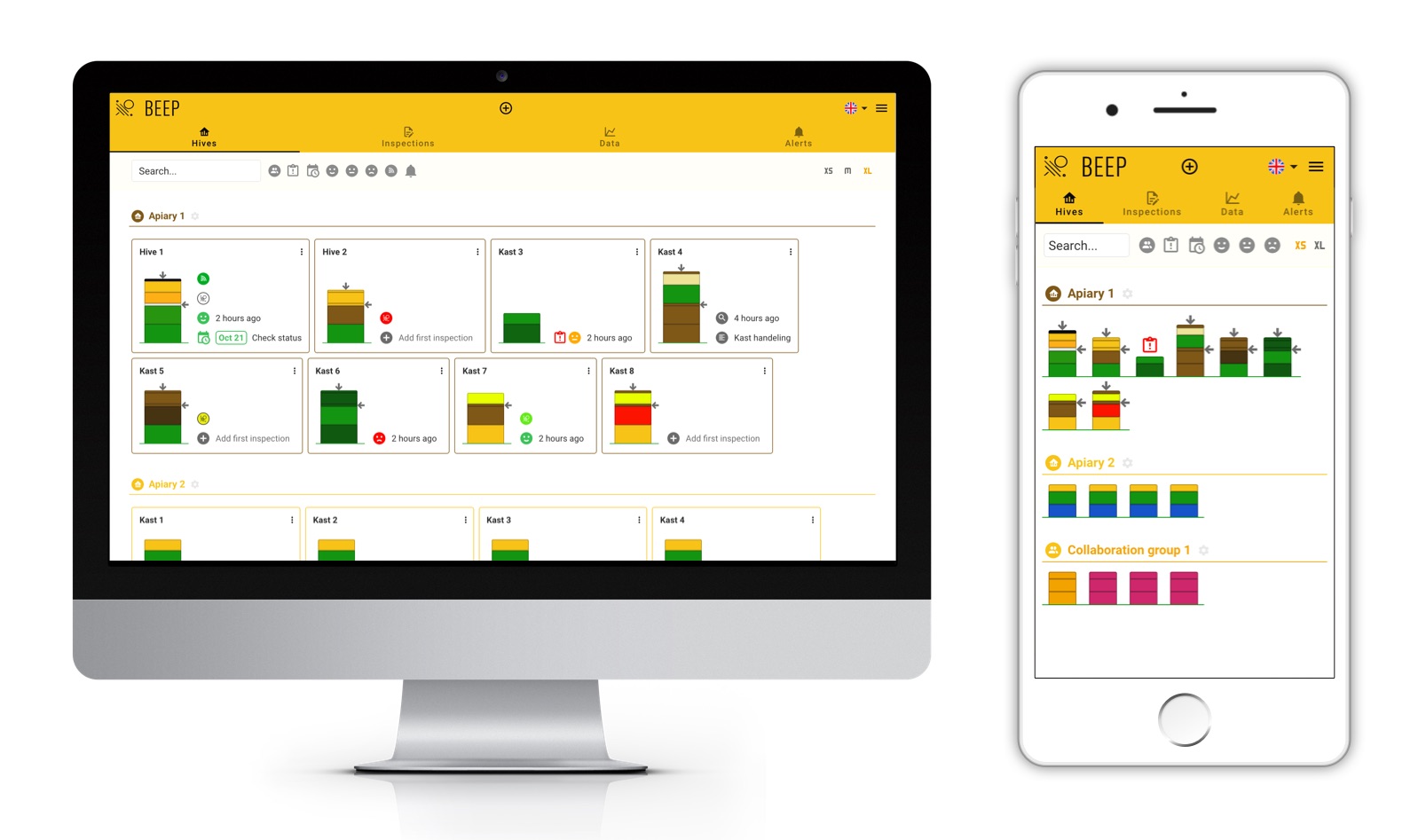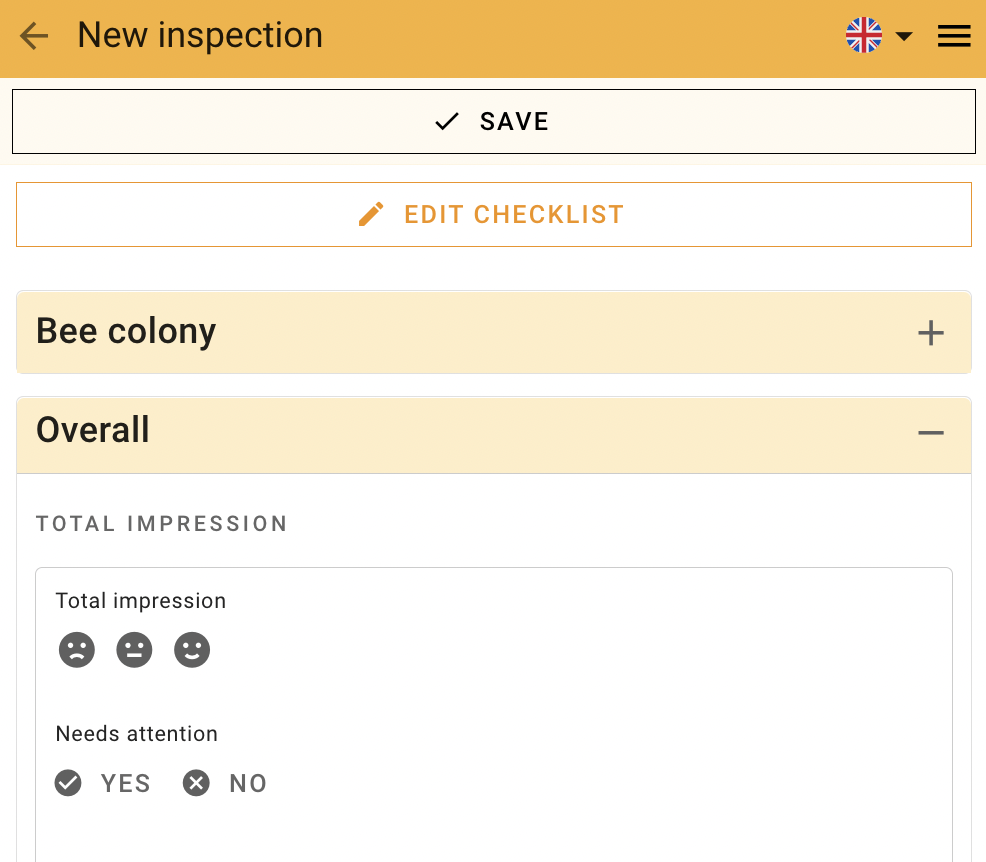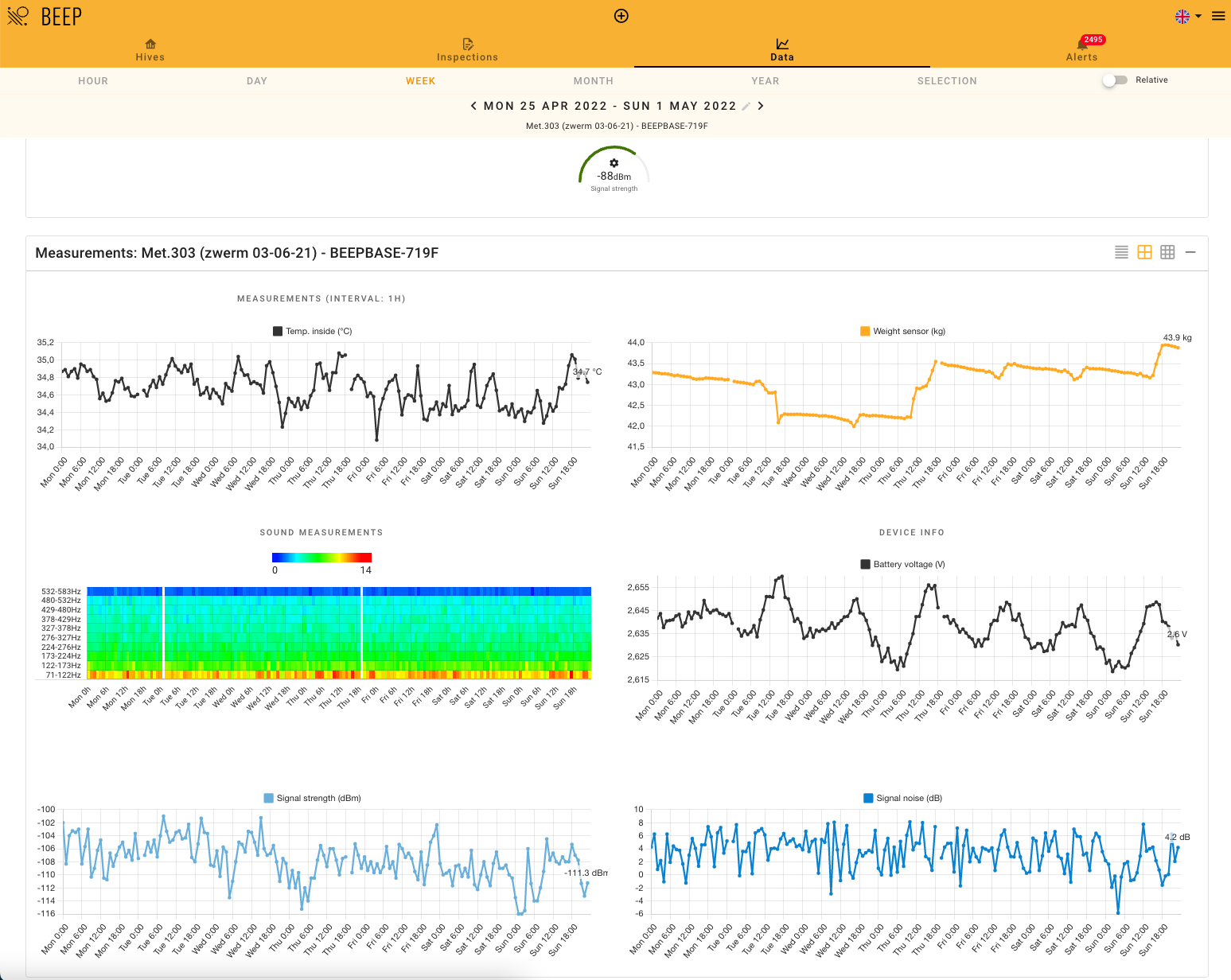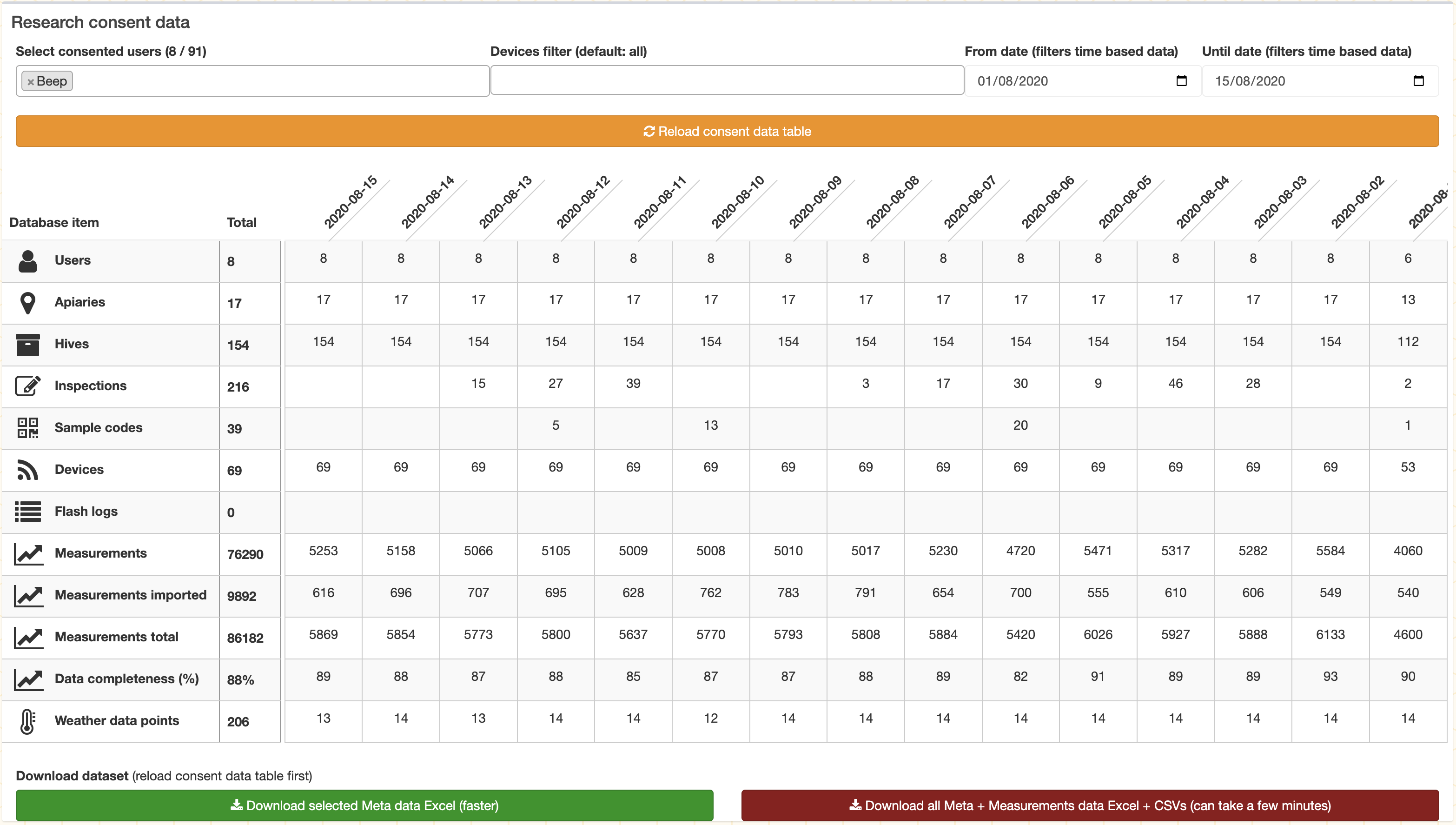Research
The BEEP app and BEEP base are tools for the collection of data for your (honeybee) research project. Collect quantitative and qualitative data with the combination of the BEEP hardware and software, design your study with a customised inspection sheet for the manual data collection and invite beekeepers to participate in your research project.
 The BEEP platform has been extended and was used in the European project B-GOOD H2020 Project by researchers and beekeepers in 15 countries, using 400 sensor systems and collecting over 12,5 million datapoints. BEEP platform is now available for new research projects! We present on the poster how this research platform can be used in new research projects in three steps:
The BEEP platform has been extended and was used in the European project B-GOOD H2020 Project by researchers and beekeepers in 15 countries, using 400 sensor systems and collecting over 12,5 million datapoints. BEEP platform is now available for new research projects! We present on the poster how this research platform can be used in new research projects in three steps:
1. Configure hard- and software (note: using hardware is optional. You can add your own device using the BEEP 'API');
2. Collect data and monitor progress and quality;
3. Analyse and use the data and optionally add your own algorithms and prediction models.
The full size poster is available here.
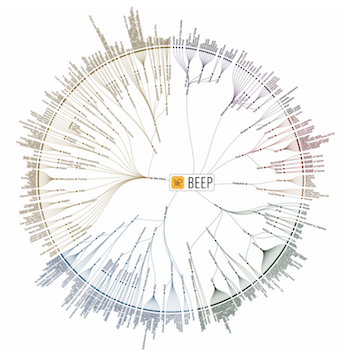 The BEEP platform is an 'open research' platform, which allows you to obtain high-quality data and monitor bee colonies in a harmonized and standardized way. To allow for this harmonization in data collection, the BEEP foundation has compiled a standardised data model. It is based on about 30 sources like beekeeping logbooks, apiary management systems, digital record keeping tools, the COLOSS BEEBOOK, the Healthy-B toolbox, FAO's honey bee diseases guide and various websites. More information on the data model can be found here.
The BEEP platform is an 'open research' platform, which allows you to obtain high-quality data and monitor bee colonies in a harmonized and standardized way. To allow for this harmonization in data collection, the BEEP foundation has compiled a standardised data model. It is based on about 30 sources like beekeeping logbooks, apiary management systems, digital record keeping tools, the COLOSS BEEBOOK, the Healthy-B toolbox, FAO's honey bee diseases guide and various websites. More information on the data model can be found here.
Users can adapt and optimise checklists, work plans, scientific protocols and manuals to suit your project. Field observations and lab analysis sampling for diseases can be performed, to get a complete picture of the bee health status. The BEEP base, an automatic measurement system, can be used for automatic data collection. Other systems can also be used for that purpose. Since BEEP is an open source platform, you can add your own sensors and/or devices, and link systems through the BEEP API. All collected data can be found and downloaded from the BEEP app, where it is displayed in graphs, lists and available as a raw dataset.
|
|
|
Using the BEEP platform for research
|
|
Data collection through standardised inspection sheets With the BEEP app you can personalise multiple inspection sheets for your specific interest or purpose, which can change during the year or project timeline. Those inspection sheets can be short and simple or more elaborate, depending on your needs. It supports various types of beekeeping practices like Varroa mite treatment, colony characteristics determination for queen selection, or swarm control. You can create multiple checklists based on the BEEP data standard and share them with participating beekeepers and researchers. |
|
|
Automatic data collection through the BEEP base or other device, with real time overviews The BEEP base is an automatic measurement system that collects weight, sound and temperature data on a set interval. The data are sent to the BEEP server over the LoRa network and accessible in the BEEP webapp. The data are visible in graphs and can be downloaded for analysis. The data are also stored on the BEEP base and can be directly downloaded to the server with the Bluetooth connection of the BEEP base app (available on iOS and Android). |
|
|
| |
Data input: inspection data / measurement data / weather / qualitative and quantitative / pictures / lab data The data in the BEEP webapp consist of your own inspection data with an option for notes and pictures when needed, weather data fetched from a weather data service is loaded automatically, measurement data from the BEEP base or another measurement device. Create sample ID tracking for laboratory research. |
|
|
Data storage and access in one place The BEEP webapp is a platform where you can collect data with inspection sheets, photos, notes and reminders. If you make use of the BEEP base, the automatic measurement system, the measurement data on weight, temperature and sound are also sent to the BEEP app and stored there. You can access your data per apiary, hive or measurement system. Download your data (.xslx and .csv) to analyse it. |
||
| Data download
The research progress can be followed at api.beep.nl. Check whether the inspection sheets are being filled in and the automatic measurement data is coming through. Download all research data from here. The API also allows you to connect another measurement system to your hives. |
||
| Using formulas, algorithms and prediction models The BEEP app has an alert functionality. The user can set triggers on data such as the hive weight and take action accordingly. A range of default alert rules are provided. For example a swarming event when a decrease more than 0.5 kg triggers the alert. Notifications can be sent by email and are displayed in the BEEP webapp. Alerts can be set based on raw data but also on processed data and even predictions of the future health status of the colony. You can use existing data processing or as a researcher add your own formula, algorithm or prediction model - see the diagram on the right. |
 |
|
|
|
Technical support The BEEP helpdesk is available with information about the BEEP platform, and you can contact us directly for any questions you might have. It is also possible to schedule a call or to make an appointment to visit our office. The BEEP team is also available for project advice and design. The development of new functionalities that fit your research is also an option. |
|
|
Intuitive, multilingual interface The BEEP interface is intuitive and easy to navigate. The BEEP webapp is available in twelve languages (English, Dutch, German, French, Greek, Italian, Norse, Portuguese, Romanian, Spanisch, Finnish, Swedish) and can be translated into more languages. |
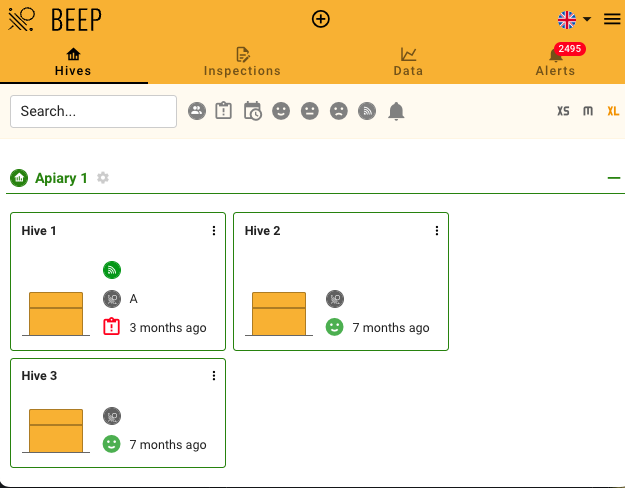 |
For examples of research projects making use of the BEEP platform, see 'Projects and partners'.
To use the BEEP plaform for your research project, please contact Marten Schoonman at marten@beep.nl
